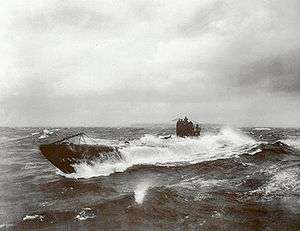SM UB-142
SM UB-142 was a German Type UB III submarine or U-boat in the German Imperial Navy (German: Kaiserliche Marine) during World War I. She was commissioned into the German Imperial Navy on 31 August 1918 as SM UB-142.[Note 1]
 UB-148 at sea, a U-boat similar to UB-142. | |
| History | |
|---|---|
| Name: | UB-142 |
| Ordered: | 27 June 1917[1] |
| Builder: | AG Weser, Bremen |
| Cost: | 4,301,000 German Papiermark |
| Yard number: | 308 |
| Launched: | 23 July 1918[2] |
| Commissioned: | 31 August 1918[2] |
| Fate: | Surrendered to France, broken up in 1921.[2] |
| General characteristics [2] | |
| Class and type: | German Type UB III submarine |
| Displacement: |
|
| Length: | 55.85 m (183 ft 3 in) (o/a) |
| Beam: | 5.80 m (19 ft) |
| Draught: | 3.75 m (12 ft 4 in) |
| Propulsion: |
|
| Speed: |
|
| Range: |
|
| Test depth: | 50 m (160 ft) |
| Complement: | 3 officers, 31 men[2] |
| Armament: |
|
| Service record | |
| Commanders: |
|
| Operations: | No patrols |
| Victories: | None |
She was surrendered to France on 22 November 1918 in accordance with the requirements of the Armistice with Germany and broken up at Landerneau in July 1921.[2]
Construction
She was built by AG Weser of Bremen and following just under a year of construction, launched at Bremen on 23 July 1918. UB-142 carried 10 torpedoes and was armed with a 10.5 cm (4.13 in) deck gun. UB-142 would carry a crew of up to 3 officer and 31 men and had a cruising range of 7,280 nautical miles (13,480 km; 8,380 mi). UB-142 had a displacement of 523 t (515 long tons) while surfaced and 653 t (643 long tons) when submerged. Her engines enabled her to travel at 13.5 knots (25.0 km/h; 15.5 mph) when surfaced and 7.5 knots (13.9 km/h; 8.6 mph) when submerged.
References
Notes
- "SM" stands for "Seiner Majestät" (English: His Majesty's) and combined with the U for Unterseeboot would be translated as His Majesty's Submarine.
Citations
- Rössler 1979, p. 56.
- Gröner 1991, pp. 25-30.
- Helgason, Guðmundur. "WWI U-boat commanders: Karl Meusel". German and Austrian U-boats of World War I - Kaiserliche Marine - Uboat.net. Retrieved 11 March 2015.
Bibliography
- Bendert, Harald (2000). Die UB-Boote der Kaiserlichen Marine, 1914-1918. Einsätze, Erfolge, Schicksal (in German). Hamburg: Verlag E.S. Mittler & Sohn GmbH. ISBN 3-8132-0713-7.CS1 maint: ref=harv (link)
- Gröner, Erich; Jung, Dieter; Maass, Martin (1991). U-boats and Mine Warfare Vessels. German Warships 1815–1945. 2. Translated by Thomas, Keith; Magowan, Rachel. London: Conway Maritime Press. ISBN 0-85177-593-4.
- Rössler, Eberhard (1979). U-Bootbau bis Ende des 1. Weltkrieges, Konstruktionen für das Ausland und die Jahre 1935 - 1945. Die deutschen U-Boote und ihre Werften (in German). I. Munich: Bernard & Graefe. ISBN 3-7637-5213-7.CS1 maint: ref=harv (link)